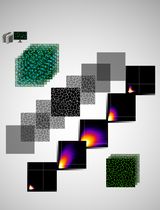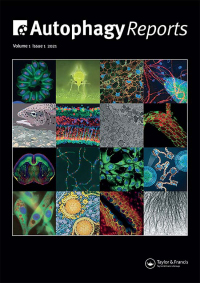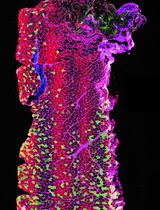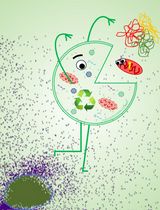- EN - English
- CN - 中文
Real-Time Autophagic Flux Measurements in Live Cells Using a Novel Fluorescent Marker DAPRed
使用新型荧光标记物DAPRed对活细胞中的自噬通量进行实时测量
发布: 2024年03月05日第14卷第5期 DOI: 10.21769/BioProtoc.4949 浏览次数: 2359

相关实验方案

基于Fiji ImageJ的全自动化流程开发:批量分析共聚焦图像数据并量化蛋白共定位的Manders系数
Vikram Aditya [...] Wei Yue
2025年04月05日 2671 阅读
Abstract
Autophagy is a conserved homeostatic mechanism involved in cellular homeostasis and many disease processes. Although it was first described in yeast cells undergoing starvation, we have learned over the years that autophagy gets activated in many stress conditions and during development and aging in mammalian cells. Understanding the fundamental mechanisms underlying autophagy effects can bring us closer to better insights into the pathogenesis of many disease conditions (e.g., cardiac muscle necrosis, Alzheimer’s disease, and chronic lung injury). Due to the complex and dynamic nature of the autophagic processes, many different techniques (e.g., western blotting, fluorescent labeling, and genetic modifications of key autophagy proteins) have been developed to delineate autophagy effects. Although these methods are valid, they are not well suited for the assessment of time-dependent autophagy kinetics. Here, we describe a novel approach: the use of DAPRed for autophagic flux measurement via live cell imaging, utilizing A549 cells, that can visualize and quantify autophagic flux in real time in single live cells. This approach is relatively straightforward in comparison to other experimental procedures and should be applicable to any in vitro cell/tissue models.
Key features
• Allows real-time qualitative imaging of autophagic flux at single-cell level.
• Primary cells and cell lines can also be utilized with this technique.
• Use of confocal microscopy allows visualization of autophagy without disturbing cellular functions.
Background
Autophagy is a highly conserved cellular process that removes unwanted or damaged cellular components [1,2]. Although first described as a mechanism to protect cells against starvation [3], it was later understood that autophagy has an important role in non-starving cells to maintain cellular homeostasis [4,5]. Currently, autophagy is recognized as being involved in organ development [6,7] and in coping with infections [8], environmental stressors [9], and aging [10]. It is also known that extreme cellular stress or insufficient autophagic response leads to the deterioration of cellular functions, possibly leading to cell death [11–14].
There are a number of different tools available to study autophagy [15], including electron microscopy and measurement of Atg8-family proteins [e.g., microtubule-associated protein 1A/1B-light chain 3 (LC3)] by various techniques including western blot, flow cytometry, immunofluorescent staining, or fluorescent microscopy, providing an assessment of autophagic activity. Autophagic proteins exhibit tissue- and cell-specific expression and different turnover rates. In addition, some of these approaches require cell fixation, permeabilization, or transfection of exogeneous fluorescent proteins. Since these procedures can alter the physiological expression of autophagy markers, they are not entirely suitable for the accurate assessment of autophagic flux (the rate of autophagosome formation over time, an indicator of autophagic activity) per se.
Live cell imaging is a valuable tool for studying biological processes. When combined with suitable fluorescent marker(s), it allows the visualization and quantification of complex biological processes, such as autophagy, in real time, even at single-cell resolution. Recently, a novel fluorescent dye, DAPRed, was developed for autophagy studies [16]. DAPRed is a small fluorescent molecule that is incorporated into the autophagosome membrane during the double membrane formation [16]. DAPRed allows the real-time visualization of autophagosomes (i.e., formation and subcellular tracking of autophagosomes), enabling autophagic flux measurement in living cells without the need for complex molecular techniques such as cloning or transduction. When DAPRed is combined with adequate imaging techniques, such as confocal or super resolution microscopy, it allows the study of autophagy kinetics and the interactions with other cellular processes (e.g., lysosomal degradation [17]). DAPRed has already been used in semiquantitative studies to address the activation of autophagy [18–20] or autophagic flux measurement [21]. Here, we describe a procedure for the measurement of autophagic flux in single live cells using DAPRed. This procedure involves cell stimulation with the positive control Rapamycin to induce autophagy and marking the plasma membrane with a fluorescently tagged tomato lectin for high spatial precision for single-cell DAPRed fluorescence detection. Autophagy is a dynamic biological process in which autophagosomes are generated and consumed upon merging with lysosomes. Autophagic activity is best described by autophagic flux, which is the rate of autophagosome generation over time. In this protocol, we explain the importance of inhibiting autophagosome–lysosome fusion and the conditions for correctly determining autophagic flux.
Materials and reagents
Polycarbonate Transwell® (tissue culture treated, permeable support of 1.13 cm2 or 12 mm diameter), 12-well plate (Costar, catalog number: 3401)
Centrifuge tubes, 15 mL (VWR, catalog number: 89039-670)
Centrifuge tubes, 50 mL (VWR, catalog number: 89079-494)
N-(2-hydroxyethyl)-piperazine-N'-(2-ethanesulfonic acid) hemisodium salt (HEPES) solution (Sigma-Aldrich, catalog number: H0887)
Dulbecco's modified Eagle's medium/nutrient mixture Ham's F-12 medium (DME/F-12) (Sigma-Aldrich, catalog number: 6421) including 15 mM HEPES and sodium bicarbonate, without L-glutamine
Fetal bovine serum (HyClone, catalog number: SH30071.03)
Bovine serum albumin (Jackson ImmunoResearch Laboratories, catalog number: 001-000-162)
L-Glutamine (Sigma-Aldrich, catalog number: G7513)
Nonessential amino acid solution (Sigma-Aldrich, catalog number: M7145)
Penicillin-Streptomycin (Sigma-Aldrich, catalog number: P4333)
Primocin (VWR, catalog number: MSPP-ANTPM1)
Dimethyl sulfoxide (DMSO) (Sigma-Aldrich, catalog number: D8418)
Microscope cover glass, 22 mm × 22 mm, No. 1. (Denville Scientific Inc., catalog number: M1100-01)
DAPRed (Dojindo Molecular Technologies, catalog number: D677-10)
Chloroquine diphosphate salt (Sigma-Aldrich, catalog number: C6628)
Rapamycin (Selleck Chemical, catalog number: s1039)
Dylight 488-conjugated tomato lectin (Vector Laboratories, catalog number: DL-1174-1)
Hoechst 33342 (Sigma-Aldrich, catalog number: H6024)
Human lung adenocarcinoma cell line A549 (ATCC, catalog number: CCL-185)
Solutions
A549 cell culture medium (MDS) (see Recipes)
Krebs-Ringer solution (see Recipes)
Recipes
A549 cell culture medium (MDS)
DME/F-12 medium supplemented with 10% fetal bovine serum, 1 mM nonessential amino acid solution, 100 U/mL primocin, 10 mM HEPES, 1.25 mg/mL bovine serum albumin, 2 mM L-glutamine, and 1 U penicillin-streptomycin.
Krebs-Ringer solution
136 mM NaCl, 4.7 mM KCl, 1 mM NaH2PO4, 1 mM CaCl2, 1 mM MgSO4, 20 mM HEPES, 1 mM D-glucose. Adjust pH to 7.4.
Equipment
FormaTM Series II Water-Jacketed CO2 incubator (Thermo Scientific, model: 3110)
Centrifuge (Eppendorf, model: 5424)
Confocal microscope (Leica Microsystems, model: Leica STELLARIS 8)
Temperature-controlled chamber: Ludin chamber type 1 (Life Imaging Services, Switzerland)
Software and datasets
Leica LAS 3D Process and Quantify Packages (Leica Microsystems)
ImageJ (National Institutes of Health)
Microsoft Excel
Procedure
文章信息
版权信息
© 2024 The Author(s); This is an open access article under the CC BY-NC license (https://creativecommons.org/licenses/by-nc/4.0/).
如何引用
Sipos, A., Kim, K. J., Alvarez, J. R. and Crandall, E. D. (2024). Real-Time Autophagic Flux Measurements in Live Cells Using a Novel Fluorescent Marker DAPRed. Bio-protocol 14(5): e4949. DOI: 10.21769/BioProtoc.4949.
分类
细胞生物学 > 基于细胞的分析方法 > 自噬活性
细胞生物学 > 细胞成像 > 共聚焦显微镜
您对这篇实验方法有问题吗?
在此处发布您的问题,我们将邀请本文作者来回答。同时,我们会将您的问题发布到Bio-protocol Exchange,以便寻求社区成员的帮助。
Share
Bluesky
X
Copy link










